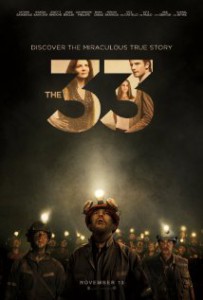33 Chilean miners are in for the fight of their lives, in this survival drama directed by Patricia Riggen. The film is the true story account of the 2010 collapse of a Chilean mine and the rescue of the 33 miners who were trapped underground for 69 days. Because of that incredibly simple plot, “The 33” should be an open and shut case on simple filmmaking, and while there is a few things of noticeable praise here, the film is ultimately weighed down by it’s questionable direction in tone, as well as a lack of focus on the events unfolding underground. It’s a TV movie of the week reduced to it’s simplest form.
The movie wastes very little time getting us involved in the events that spiraled very quickly into this disaster taking place. We are introduced to no fewer than fifty on-screen characters between the miners and their families. Immediatly, i noticed this as a huge flaw in the movie because how are we supposed to use admirable screen time to get to know their personalities? Because of this, there is never really that moment of feeling fully invested in the film or it’s characters. Plenty of times throughout the darkness of the underground scenes, i found myself being easily confused as to who is who, mainly because nobody stood out during the first act. If the film doesn’t bother with the important introductions, then how are the audience supposed to distinguish between the many varieties of vanilla personalities? I mean, the film does give a flimsy outline for certain characters, and it’s mostly the different grouping that you would normally come to despise in disaster films. There’s the leader (Antonio Banderes), the old man who has seen far too much (Federico Luppe), the morally defeated but on the road to redemption troublemaker (Juan Pablo Raba), and the young kid who everyone picks on (Pedro Calvo). It’s a formula that we have seen plenty of times, and it makes it feel even more of a task to get to know and understand the motivations of our characters. The one performance that went futher than a stereotype for me was the man in charge of operations above ground (Rodrigo Santoro). What makes his role work in particular is the transformation from political agenda to rescue savior. He realizes that he has a big responsibility to the families of these miners, and decides to do something about it when everyone else has given up. Santoro had a solid turn as Xerces in the 300 films, and it’s nice to see him from the other side of the moral coin.
One of the positives that this film has going for it is in the beautiful conematography by Checco Varese. Varese has an effortless touch to really make the deserts and dry lands of Chile alike, pop like a visual feast. He perfectly represents the burning sun above ground by focusing in closely to the heat burning off of the desert sand, as well as the transitional shots of the sun above the town. This did wonders for communicating the things underground that you wouldn’t quite think about in a movie like this. For instance, the underground temperature is 90 degrees in the morning, so how much worse it will get by the blazing hot afternoon could matter greatly in the fight for life or death. Most of this film is shot pretty tightly in the positive column. Riggen’s abandonment of a direction for the blend of above ground versus below is one of her biggest flaws (More on that in a second), but it’s her touch behind a camera’s art direction that shows a lot of promise in her future. Riggen is of Mexican decent, so it’s perfectly clear that the events of the subject matter hit extra close to home for her. I think she was the right person for the job, but i wonder her thought process for the overwhelming ratio of above ground scenes compared to the underground reason why the audience is here in the first place.
I understand greatly that the audience has to understand the events that led to the rescue of these miners, but there were times during the film when i forgot who we were here to save in the first place. The film far too often forgets our miners for dramatic periods of time, and when it does focus on them, we get an awkwardly comedic scene in dialogue. This does a lot of damage, as a lot of the time the audience is laughing too much to take anything seriously. A film with a story like this should be an Oscar dreamboat, but so many useless scenes of comedy will serve as a shameful reminder as to why this film won’t be seen at the awards come March. For a film like this to be two hours long isn’t a problem, but not when it’s focus is on the waiting game of the families above ground. If you want to go this route, fine, but for this coma-inducing bore to be the majority is ridiculous. I can see many of my readers being bored into turning the television off for this film, and that’s a shame when a story as inspiring as this is given such a careless attitude.
Overall, “The 33” is a film that isn’t worth saving. In trying expose the audcience to too many characters, the screenplay transforms them all into thinly-drawn caricatures. It’s heart is in the right place, but it’s head is often above ground, in a place opposite of where it needs to be. Interestingly enough, the biggest thing that “The 33” lacks is heart in it’s source material to pay respect to the victims, while giving the audience a film that they can rave about. This one is in too deep to ever dig out.
5/10
